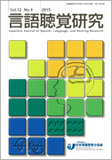Japanese
English
- 有料閲覧
- Abstract 文献概要
- 1ページ目 Look Inside
- 参考文献 Reference
角回を含む左頭頂後頭境界部の脳梗塞により異書体性失書を呈した60歳代右利き男性を対象に,平仮名と片仮名の形態の差異が仮名文字の書取に与える影響を検討した.発症から約1か月間に100単音節の仮名書取課題を3回行い,正答率と各誤反応出現率を調べた.また,文字形態の視空間的構造の複雑性やストロークの共通性が正答率と異書体の誤りに関与するか分析した.発症初期,平仮名は片仮名よりも正答率が低く,異書体の誤りの出現率が高かった.平仮名では新作文字が約1か月を通し出現したのに対し,片仮名ではほとんどなかった.平仮名の中でも複雑な形態の文字は異書体の誤りを生じやすく,ストロークの共通性の違いは影響しなかった.曲線や交点が多い複雑な視空間構造の平仮名は文字形態の視覚心像の想起や把持が困難と推察され,異書体の発現に視空間的構造が関与している可能性が示唆された.また,文字表象の適切な賦活と抑制が困難な可能性も考えられた.
We investigated the effect of the form difference between hiragana and katakana on the performance of dictation in a case of allographic agraphia. The subject was a right-handed male in the 60s who suffered a stroke resulting in an infarction of the cortical area around the left angular gyrus. In writing, he showed substitution errors, particularly when converting characters from hiragana to katakana. We examined his performance on writing hiragana and katakana characters listening to 100 monosyllabic stimuli. We repeated the same dictation task 3 times in about one month after the onset and analyzed the correct and error response ratios. We also analyzed whether the complexity of the visuospatial structure of the character forms and the commonality of strokes would affect the correct ratio and allographic error ratios. The results show that the correct ratio for hiragana was significantly lower and the allographic error ratio for hiragana was significantly higher than for katakana. The hiragana characters with complex visuospatial structure were more likely to cause allographic errors. No significant difference was found in the allographic error ratio by the commonality of strokes. This indicates that it may be difficult to recall and retain the visual imagery of hiragana character form and that the allographic errors are related to the complexity of visuospatial structures. It also suggests that the inappropriate activation and inhibition of the character representation may also play a role in producing allographic errors.

Copyright © 2015, Japanese Association of Speech-Language-Hearing Therapists. All rights reserved.


